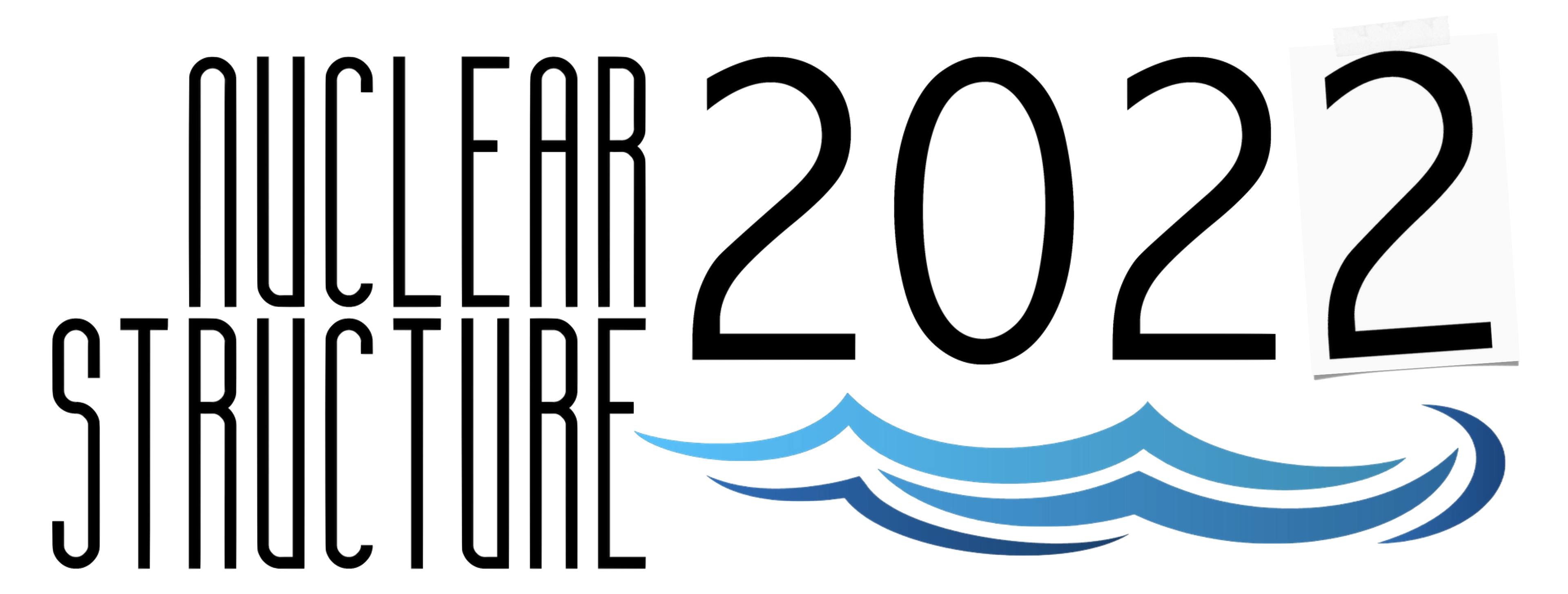The neutron and proton mid-shell region, around N = 60 and Z = 40, is renowned for a sudden drop of first 2$^{+}$ state energy in even-even isotopes indicating shape deformation at N = 60 [1-5]. Type Ⅱ shell evolution is suggested to explain the origin of this shape deformation [6, 7] but more experimental data is required to understand this region. In order to figure out the structural properties of corresponding nuclei, there have been studies on molybdenum nuclei (Z = 42) with N ≥ 60 [5, 8-11]. However, the detailed quasiparticle configuration remains undetermined and recent experimental study on $^{106, 108, 110}$Mo also showed some discrepancies from theoretic calculation in side bands especially on $^{110}$Mo [5]. In studying the strongly deformed region, the even-odd nuclei play an important role to understand the neutron quasi-particle states near the Fermi surface.
In the present study, the low-lying states in $^{109}$Mo were investigated by measuring the delayed $\gamma$-rays after the $\beta$ decay of $^{109}$Nb for the first time under the EURICA project in RIKEN. Two new isomeric $\gamma$-rays were measured together with the 69-keV $\gamma$-ray from the known isomer [11, 12]. The internal conversion coefficients of the isomeric $\gamma$-rays were quantitively studied for the first time. The most like quasi-particle configuration for the ground and isomeric states were assigned considering measured mean lifetime, decay branches, and coincidence counts. One more quasi-particle state was newly assigned to a new exited state strongly populated by the $\beta$ decay of $^{109}$Nb. Our results will give useful restrictions for theoretical models in this region. We will present the experimental results and discuss the quasi-particle configurations of the low-lying states in $^{109}$Mo.
[1] H. Wollnik et al., Nucl. Phys. A 291, 2, p. 355, 1977.
[2] R. E. Azuma et al., Phys. Lett. B 86, 1, p. 5, 1979.
[3] M. A. C. Hotchkis et al., Nucl. Phys. A 530, 1, p. 111, 1991.
[4] T. Sumikama et al., Phys. Rev. Lett. 106, 202501, 2011.
[5] J. Ha et al., Phys. Rev. C 101, 044311, 2020.
[6] T. Togashi et al., Phys. Rev. Lett. 117, 172502, 2016.
[7] T Otsuka and Y Tsunoda 2016 J. Phys. G: Nucl. Part. Phys. 43 024009.
[8] W. Urban et al., Phys. Rev. C 73, 037302, 2006.
[9] C. Goodin et al., Phys. Rev. C 80, 014318, 2009.
[10] J. Marcellino et al., Phys. Rev. C 96, 034319, 2017.
[11] W. Urban et al., Phys. Rev. C 102, 024318, 2020.
[12] D. Kameda et al., Phys. Rev. C 86, 054319, 2012.
Frank Browne
(RIKEN Nishina Center, Japan, School of Computing, Engineering, and Mathematics, University of Brighton, United Kingdom)
Alison Bruce
(School of Computing, Engineering, and Mathematics, University of Brighton, United Kingdom)
Seonho Choi
(Department of Physics and Astronomy, Seoul National University, Republic of Korea)
Ippei Nishizuka
(Department of Physics, Tohoku University, Japan)
Shunji Nishimura
(RIKEN Nishina Center, Japan)
Pieter Doornenbal
(RIKEN Nishina Center, Japan)
Giuseppe Lorusso
(RIKEN Nishina Center, Japan, Department of Physics, University of Surrey, United Kingdom, National Physical Laboratory, United Kingdom)
Pär-Anderson Söderström
(RIKEN Nishina Center, Japan)
Hiroshi Watanabe
(RIKEN Nishina Center, Japan, IRCNPC, School of Physics and Nuclear Energy Engineering, Beihang University, China)
Rie Daido
(Department of Physics, Osaka University, Japan)
Zena Patel
(RIKEN Nishina Center, Japan, Department of Physics, University of Surrey, United Kingdom)
Simon Rice
(RIKEN Nishina Center, Japan, Department of Physics, University of Surrey, United Kingdom)
Laura Sinclair
(RIKEN Nishina Center, Japan, Department of Physics, University of York, United Kingdom)
Jin Wu
(RIKEN Nishina Center, Japan, Department of Physics, Peking University, China)
Zhengyu Xu
(Department of Physics, University of Tokyo, Japan, Department of Physics, University of Hong Kong, Hong Kong)
Ayumi Yagi
(Department of Physics, Osaka University, Japan)
Hidetada Baba
(RIKEN Nishina Center, Japan)
Nobuyuki Chiga
(Department of Physics, Tohoku University, Japan, RIKEN Nishina Center, Japan)
Robert Carroll
(Department of Physics, University of Surrey, United Kingdom)
Francois Didierjean
(IPHC, CNRS/IN2P3, Université de Strasbourg, France)
Yifan Fang
(Department of Physics, Osaka University, Japan)
Naoki Fukuda
(RIKEN Nishina Center, Japan)
Guillaume Gey
(LPSC, Université Grenoble-Alpes, CNRS/IN2P3, France, ILL, France)
Eiji Ideguchi
(Department of Physics, Osaka University, Japan)
Naohito Inabe
(RIKEN Nishina Center, Japan)
Tadaaki Isobe
(RIKEN Nishina Center, Japan)
Daisuke Kameda
(RIKEN Nishina Center, Japan)
Ivan Kojouharov
(GSI Helmholtzzentrum für Schwerionenforschung GmbH, Germany)
Nikolaus Kurz
(GSI Helmholtzzentrum für Schwerionenforschung GmbH, Germany)
Toshiyuki Kubo
(RIKEN Nishina Center, Japan)
Stefan Lalkovski
(Department of Physics, University of Sofia, Bulgaria)
Zhihuan Li
(Department of Physics, Peking University, China)
Radomira Lozeva
(IPHC, CNRS/IN2P3, Université de Strasbourg, France, CSNSM, CNRS/IN2P3, Université Paris-Sud, France)
Hiroki Nishibata
(Department of Physics, Osaka University, Japan)
Atsuko Odahara
(Department of Physics, Osaka University, Japan)
Zsolt Podolyák
(Department of Physics, University of Surrey, United Kingdom)
Patrick Regan
(Department of Physics, University of Surrey, United Kingdom, National Physical Laboratory, United Kingdom)
Oliver Roberts
(School of Computing, Engineering, and Mathematics, University of Brighton, United Kingdom)
Hiroyoshi Sakurai
(RIKEN Nishina Center, Japan)
Henning Schaffner
(GSI Helmholtzzentrum für Schwerionenforschung GmbH, Germany)
Gary Simpson
(LPSC, Université Grenoble-Alpes, CNRS/IN2P3, France)
Hiroshi Suzuki
(RIKEN Nishina Center, Japan)
Hiroyuki Takeda
(RIKEN Nishina Center, Japan)
Mana Tanaka
(Department of Physics, Osaka University, Japan, Research Center for Nuclear Physics (RCNP), Osaka University, Japan)
Jan Taprogge
(RIKEN Nishina Center, Japan, Departamento de Física Teórica, Universidad Autónoma de Madrid, Spain, Instituto de Estructura de la Materia, CSIC, Spain)
Volker Werner
(A. W. Wright Nuclear Structure Laboratory, Yale University, USA, Institut für Kernphysik, Technische Universität Darmstadt, Germany)
Oliver Wieland
(INFN Sezione di Milano, Italy)

